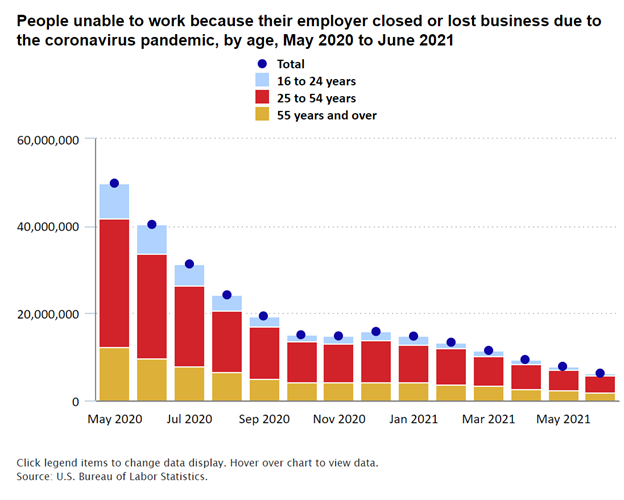In the fast-paced and unpredictable world of business, disruptions are inevitable. Whether it’s a cyber-attack, natural disaster, hardware failure, or even human error, these unexpected events can have severe consequences on a company’s operations, reputation, and bottom line. Moreover, the recent global pandemic, which caught the world off-guard, demonstrated the profound impact such crises can have on businesses.
“In June 2021, of the 6.2 million people in US alone that did not work at all or worked fewer hours at some point in the last 4 weeks because their employer closed or lost business due to the coronavirus pandemic” [1]

“About 25 percent of businesses do not reopen after disasters.” In times of uncertainty and crisis, Business Continuity and Disaster Recovery (BCDR) emerge as the essential safety net, providing businesses with the resilience and adaptability needed to weather the storm and emerge stronger. In this blog, we will explore the paramount importance of BCDR from a business perspective, particularly in light of the lessons learned from the pandemic, and how workflow automation software can serve as a critical supporting pillar for a robust continuity strategy.
The Significance of BCDR from Businesses Perspective

- Ensuring Uninterrupted Operations
Business continuity is the ability of an organization to maintain essential functions and operations during and after a disruptive event. BCDR plans are designed to keep businesses running, ensuring that critical processes, systems, and services continue to function, even in the face of adversity. This translates to minimal downtime and reduced financial losses during disruptions, instilling confidence in stakeholders and customers alike.”From 2019 through 2022, 96% of organizations experienced at least one incidence of downtime”. “For more than 90% of mid-sized and large enterprises, the cost of downtime exceeds $300,000 an hour”[2] - Mitigating Risks and Protecting Data
Disasters can strike without warning, putting businesses at risk of losing valuable data and assets. “83% of organizations have experienced multiple data breaches” as per IBM [3]. BCDR strategies involve robust data backup, replication, and secure storage, mitigating the risk of data loss. Additionally, it provides a framework to identify potential risks and vulnerabilities, enabling proactive measures to minimize their impact. - Meeting Regulatory and Compliance Requirements
For businesses operating in regulated industries, compliance with industry standards and government regulations is non-negotiable. BCDR plans demonstrate an organization’s commitment to protecting critical assets and customer data, which can be crucial in maintaining legal compliance and winning the trust of customers.
Leveraging Workflow Automation Software for BCDR

- Streamlining BCDR Processes
Workflow automation software can be a game-changer for BCDR, as it helps streamline the implementation of continuity plans. By automating various tasks, such as data backup, system monitoring, and incident response, businesses can react swiftly to disruptions, minimizing recovery time and reducing human errors. Cloud enabled data back up and recovery options are increasingly becoming preferred choice for organizations of all sizes. As per Unitrends 2019 survey, “84 percent of all businesses store data or backups in the cloud.” - Enhancing Disaster Recovery Efficiency
In times of crisis, every second counts. Workflow automation software can expedite disaster recovery by orchestrating the recovery process, automating failover and failback procedures, and ensuring seamless collaboration among teams. This increased efficiency enables businesses to bounce back with minimal disruptions to operations. - Real-time Monitoring and Alerts
Workflow automation software can provide real-time monitoring of critical systems and applications, instantly detecting anomalies or failures. It can trigger automated alerts to relevant teams, enabling them to take immediate action and mitigate potential risks before they escalate into major issues. - Improving Documentation and Compliance
BCDR plans require detailed documentation and periodic testing to ensure their effectiveness. Workflow automation software can assist in documenting the entire BCDR process, making it easier to manage and update. Moreover, it can automate the testing and auditing of BCDR plans, ensuring compliance with regulatory requirements.
Optimizing Workflow Automation with Cloud Deployment

- Cloud-Powered Scalability
Workflow automation software in the cloud benefits from its inherent scalability. As businesses grow, their automation needs may expand exponentially. Cloud deployment allows seamless expansion of resources to accommodate increased automation requirements, supporting business growth without disruptions. “Percentage of all organizations that operate 100% cloud-hosted workloads is expected to increase by 70% by 2023”[4] - Enhanced Collaboration and Accessibility
With workflow automation software deployed in the cloud, teams can collaborate in real-time, regardless of their physical locations. Cloud-based solutions enable secure access to automated workflows from anywhere, promoting efficient communication and collaboration between teams, remote or on-site. - Automatic Updates and Maintenance
Cloud deployment alleviates the burden of manual software updates and maintenance. Vendors regularly roll out updates and patches to ensure the software remains secure and up-to-date, freeing businesses from managing these tasks and allowing them to focus on core activities. - Disaster-Resilient Automation
By hosting workflow automation software in the cloud provided by cloud provider such as Microsoft Azure, businesses ensure that critical automated processes remain unaffected during disruptions. Cloud service providers maintain high levels of redundancy and fault tolerance, ensuring continuous automation operations even in the event of hardware failures or localized disasters.
From a business perspective, Business Continuity and Disaster Recovery (BCDR) are not just concepts but the foundation of resilience and growth. The ability to withstand disruptions, protect critical assets, and maintain uninterrupted operations is paramount for long-term success. However, achieving these goals can be challenging without the right tools. This is where Microsoft cloud-based Software as a Service workflow automation solution such as AffableBPM becomes a critical supporting element. By streamlining BCDR processes, enhancing efficiency, and providing real-time insights, workflow automation software such as AffableBPM empowers businesses to navigate through turbulent times with agility and confidence. Embracing BCDR with workflow automation software is an investment in the future, fostering a culture of preparedness and responsiveness that will enable businesses to thrive in an increasingly uncertain world.
[1] https://www.bls.gov/opub/ted/2021/6-2-million-unable-to-work-because-employer-closed-or-lost-business-due-to-the-pandemic-june-2021.htm
[2] https://invenioit.com/continuity/disaster-recovery-statistics/
[3] https://www.ibm.com/reports/data-breach

